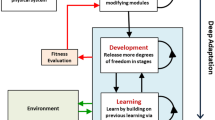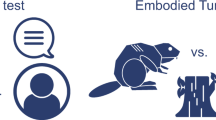Abstract
The human brain is the best example of intelligence known, with unsurpassed ability for complex, real-time interaction with a dynamic world. AI researchers trying to imitate its remarkable functionality will benefit by learning more about neuroscience, and the differences between Natural and Artificial Intelligence. Steps that will allow AI researchers to pursue a more brain-inspired approach to AI are presented. A new approach that bridges AI and neuroscience is described, Embodied Cultured Networks. Hybrids of living neural tissue and robots, called hybrots, allow detailed investigation of neural network mechanisms that may inform future AI. The field of neuroscience will also benefit tremendously from advances in AI, to deal with their massive knowledge bases and help understand Natural Intelligence.
Access this chapter
Tax calculation will be finalised at checkout
Purchases are for personal use only
Preview
Unable to display preview. Download preview PDF.
Similar content being viewed by others
References
Lazebnik, Y.: Can a biologist fix a radio?—Or, what I learned while studying apoptosis. Cancer Cell 2, 179–182 (2002)
Purves, D., Augustine, G.J., Fitzpatrick, D., Hall, W.C., Lamantia, A.S., McNamara, J.O., et al.: Neuroscience, 3rd edn. Sinauer Associates, New York (2004)
Bear, M.F., Connors, B., Paradiso, M.: Neuroscience: Exploring the Brain. Lippincott Williams & Wilkins, New York (2006)
Kandel, E.R., Schwartz, J.H., Jessel, T.M.: Principles of Neural Science, 4th edn. McGraw-Hill Publishing Co., New York (2000)
von Neumann, J.: The Computer and the Brain. Yale University Press, New Haven (1958)
Tononi, G., Sporns, O., Edelman, G.M.: A Measure for Brain Complexity: Relating Functional Segregation and Integration in the Nervous System. PNAS 91(11), 5033–5037 (1994)
Kosslyn, S.M., Pascual-Leone, A., Felician, O., Camposano, S., Keenan, J.P., Thompson, W.L., et al.: The role of area 17 in visual imagery: convergent evidence from PET and rTMS. Science 284(5411), 167–170 (1999)
Alberini, C.M., Milekic, M.H., Tronel, S.: Mechanisms of memory stabilization and de-stabilization. Cell Mol. Life Sci. 63(9), 999–1008 (2006)
Bell, A.J.: Levels and loops: the future of artificial intelligence and neuroscience. Philosophical Transactions of the Royal Society of London Series B-Biological Sciences 354(1392), 2013–2020 (1999)
Buzsaki, G.: Rhythms of the Brain. Oxford U. Press, Oxford (2006)
Wehr, M., Laurent, G.: Odour encoding by temporal sequences of firing in oscillating neural assemblies. Nature 384(6605), 162–166 (1996)
Yuste, R., Majewska, A.: On the function of dendritic spines. Neuroscientist 7(5), 387–395 (2001)
Liu, S.-C., Kramer, J., Indiveri, G., Delbrück, T., Douglas, R.: Analog VLSI: Circuits and Principles. MIT Press, Cambridge (2002)
Reich, D.S., Mechler, F., Purpura, K.P., Victor, L.D.: Interspike intervals, receptive fields, and information encoding in primary visual cortex. Journal of Neuroscience 20(5), 1964–1974 (2000)
Froemke, R.C., Dan, Y.: Spike-timing-dependent synaptic modification induced by natural spike trains. Nature 416(6879), 433–438 (2002)
Lungarella, M., Pegors, T., Bulwinkle, D., Sporns, O.: Methods for Quantifying the Informational Structure of Sensory and Motor Data. Neuroinformatics 3, 243–262 (2005)
Lungarella, M., Sporns, O.: Map** Information Flow in Sensorimotor Networks. PLOS Computational Biology 2, 1301–1312 (2006)
Mehta, S.B., Whitmer, D., Figueroa, R., Williams, B.A., Kleinfeld, D.: Active Spatial Perception in the Vibrissa Scanning Sensorimotor System. PLoS Biol. 5(2), e15 (2007)
Chiel, H.J., Beer, R.D.: The brain has a body: adaptive behavior emerges from interactions of nervous system, body and environment. Trends in Neurosciences 20(12), 553–557 (1997)
Lipson, H.: Curious and Creative Machines. In: The 50th Anniversary Summit of Artificial Intelligence, Ascona, Switzerland (2006)
Sporns, O., Tononi, G., Edelman, G.M.: Connectivity and complexity: the relationship between neuroanatomy and brain dynamics. Neural Networks 13(8-9), 909–922 (2000)
Stoffregen, T.A., Pittenger, J.B.: Human echolocation as a basic form of perception and action. Ecological Psychology 7, 181–216 (1995)
Bach-y-Rita, P.: Brain Mechanisms in Sensory Substitution. Academic Press, New York (1972)
Dennett, D.C.: Consciousness Explained. Little, Brown & Co., Boston (1991)
Ramon y Cajal, S.: Histologie du Systeme Nervex de l’Homme et des Vertebres. Maloine, Paris (1911)
Ramon y Cajal, S.: Les nouvelles idées sur la structure du système nerveux chez l’homme et chez les vertébrés (L. Azoulay, Trans.). C. Reinwald & Cie, Paris (1894)
Kalinichenko, S.G., Okhotin, V.E.: Unipolar brush cells–a new type of excitatory interneuron in the cerebellar cortex and cochlear nuclei of the brainstem. Neurosci. Behav. Physiol. 35(1), 21–36 (2005)
Sporns, O., Tononi, G., Kötter, R.: The Human Connectome: A Structural Description of the Human Brain. PLOS Computational Biology 1, 245–251 (2005)
Watts, D.J., Strogatz, S.H.: Collective dynamics of ’small-world’ networks. Nature 393(6684), 440–442 (1998)
Gerstner, W., Kreiter, A.K., Markram, H., Herz, A.V.M.: Neural codes: Firing rates and beyond. Proc. Natl. Acad. Sci. USA 94, 12740–12741 (1997)
Bi, G.Q., Poo, M.M.: Synaptic modifications in cultured hippocampal neurons: Dependence on spike timing, synaptic strength, and postsynaptic cell type. Journal of Neuroscience 18, 10464–10472 (1998)
Izhikevich, E.M.: Polychronization: Computation with spikes. Neural Computation 18(2), 245–282 (2006)
Maass, W., Natschlager, T., Markram, H.: Real-time computing without stable states: a new framework for neural computation based on perturbations. Neural Comput. 14(11), 2531–2560 (2002)
Markram, H.: The blue brain project. Nat. Rev. Neurosci. 7(2), 153–160 (2006)
Mel, B.W.: Information-processing in dendritic trees. Neural Computation 6, 1031–1085 (1994)
Weiler, I.J., Hawrylak, N., Greenough, W.T.: Morphogenesis in Memory Formation - Synaptic and Cellular Mechanisms. Behavioural Brain Research 66(1-2), 1–6 (1995)
Majewska, A., Sur, M.: Motility of dendritic spines in visual cortex in vivo: Changes during the critical period and effects of visual deprivation. Proc. Natl. Acad. Sci. USA 100(26), 16024–16029 (2003)
Leuner, B., Falduto, J., Shors, T.J.: Associative Memory Formation Increases the Observation of Dendritic Spines in the Hippocampus. J. Neurosci. 23(2), 659–665 (2003)
DeMarse, T.B., Wagenaar, D.A., Potter, S.M.: The neurally-controlled artificial animal: A neural-computer interface between cultured neural networks and a robotic body. Society for Neuroscience Abstracts 28, 347.1 (2002)
DeMarse, T.B., Wagenaar, D.A., Blau, A.W., Potter, S.M.: The neurally controlled animat: Biological brains acting with simulated bodies. Autonomous Robots 11, 305–310 (2001)
Bakkum, D.J., Shkolnik, A.C., Ben-Ary, G., Gamblen, P., DeMarse, T.B., Potter, S.M.: Removing some ‘A’ from AI: Embodied Cultured Networks. In: Iida, F., Pfeifer, R., Steels, L., Kuniyoshi, Y. (eds.) Embodied Artificial Intelligence. LNCS (LNAI), vol. 3139, pp. 130–145. Springer, Heidelberg (2004)
Potter, S.M., Wagenaar, D.A., DeMarse, T.B.: Closing the Loop: Stimulation Feedback Systems for Embodied MEA Cultures. In: Taketani, M., Baudry, M. (eds.) Advances in Network Electrophysiology using Multi-Electrode Arrays, pp. 215–242. Springer, New York (2006)
Potter, S.M.: Two-photon microscopy for 4D imaging of living neurons. In: Yuste, R., Konnerth, A. (eds.) Imaging in Neuroscience and Development: A Laboratory Manual, pp. 59–70. Cold Spring Harbor Laboratory Press (2005)
Potter, S.M., DeMarse, T.B.: A new approach to neural cell culture for long-term studies. J. Neurosci. Methods 110, 17–24 (2001)
Bakkum, D.J., Chao, Z.C., Gamblen, P., Ben-Ary, G., Potter, S.M.: Embodying Cultured Networks with a Robotic Drawing Arm. In: The 29th IEEE EMBS Annual International Conference (2007)
Granger, R.: Engines of the brain: the computational instruction set of human cognition. AI Magazine 27, 15 (2006)
Linares-Barranco, A., Jiminez-Moreno, G., Linares-Barranco, B., Civit-Balcells, A.: On Algorithmic Rate-Coded AER Generation. IEEE Transactions on Neural Networks 17, 771–788 (2006)
Seth, A.K., McKinstry, J.L., Edelman, G.M., Krichmar, J.L.: Visual binding through reentrant connectivity and dynamic synchronization in a brain-based device. Cerebral Cortex 14, 1185–1199 (2004)
Damasio, A.R.: Descartes’ Error: Emotion, Reason, and the Human Brain. Gosset/Putnam Press, New York (1994)
Author information
Authors and Affiliations
Editor information
Rights and permissions
Copyright information
© 2007 Springer-Verlag Berlin Heidelberg
About this chapter
Cite this chapter
Potter, S.M. (2007). What Can AI Get from Neuroscience?. In: Lungarella, M., Iida, F., Bongard, J., Pfeifer, R. (eds) 50 Years of Artificial Intelligence. Lecture Notes in Computer Science(), vol 4850. Springer, Berlin, Heidelberg. https://doi.org/10.1007/978-3-540-77296-5_17
Download citation
DOI: https://doi.org/10.1007/978-3-540-77296-5_17
Publisher Name: Springer, Berlin, Heidelberg
Print ISBN: 978-3-540-77295-8
Online ISBN: 978-3-540-77296-5
eBook Packages: Computer ScienceComputer Science (R0)




